Panasonic DP-UB820EB Blu-ray Player Review: Are Discs Better?


Jump to a section:
The Panasonic DP-UB820EB Blu-ray player is one of a select few that can actually play 4K discs. The choice here has dwindled to the point that you’re almost guaranteed to end up with a player from Panasonic or Sony. Yes, you can play 4K Blu-ray movies with an Xbox Series X, but what you won’t get is superior HDR10+ support for a wider colour palette. But what about streaming apps? Using the likes of Netflix on your 4K TV might be a thoroughly modern way to access your entertainment, but it’s often far from the best option for high-end sound and vision.
Remember when you could proudly display your movie collection next to your TV? Snapping up physical media (in a perhaps overambitious bid to replicate the Criterion closet) remains the last bastion of true ownership. Paying for access to stream the same media can turn out to be unreliable or even impermanent. You need the internet to stream in 4K, and a reliable fast connection at that. And we haven’t even touched on audio visual quality. Some streaming providers charge an extra fee for access to advanced surround sound formats like Dolby Atmos, not to mention offering inferior HDR formats compared to the Blu-ray disc edition. And then there’s the dreaded compression to contend with, as all streaming video is re-encoded for just that purpose. This is why discs are still preferred by many movie fans and collectors: you get the best audio-visual formats and actual ownership in one neat and displayable package.
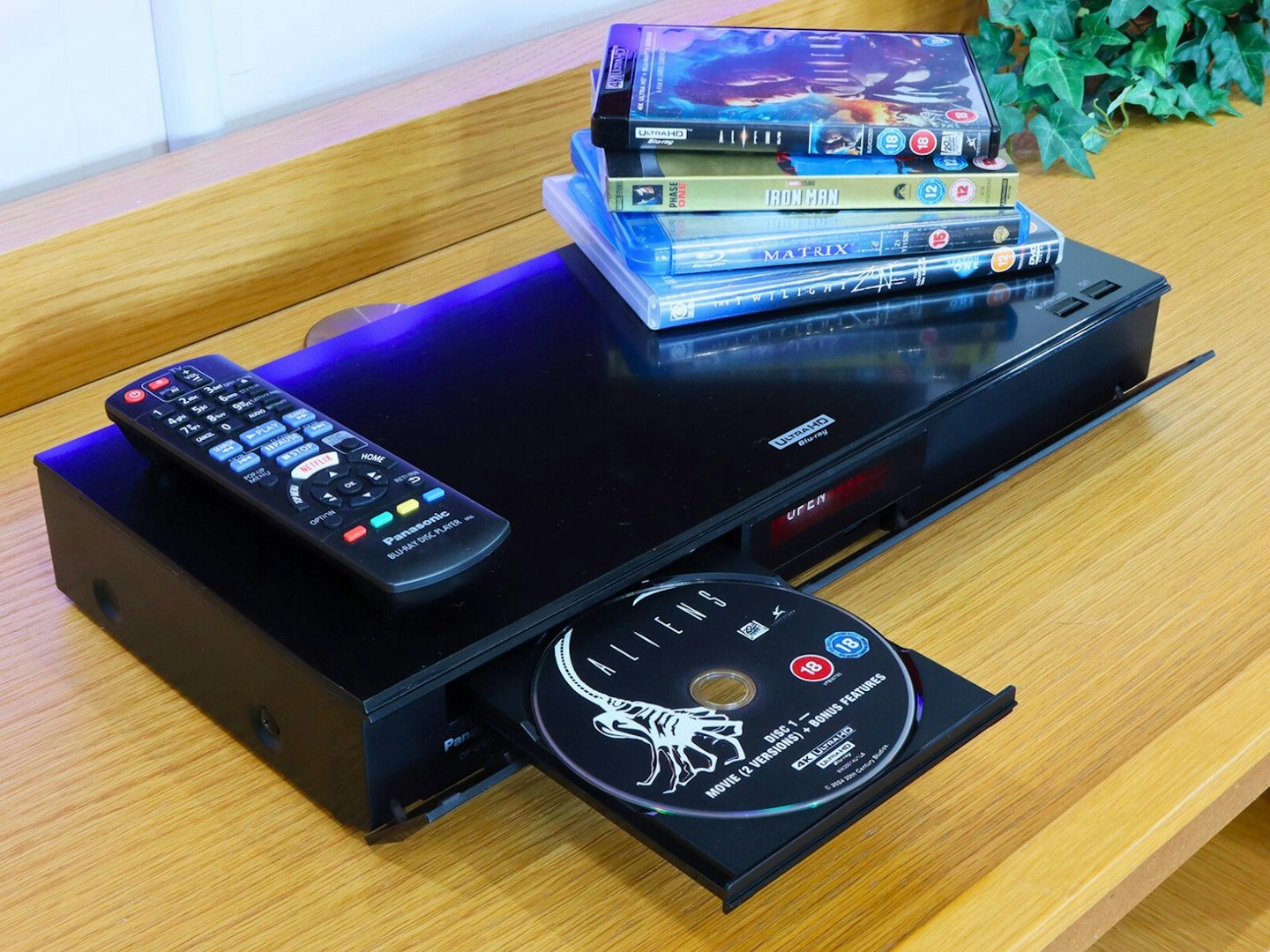
©Chris Duffill / Empire
We’ve owned our share of Panasonic kit over the years. An impressive array of features plus solid build quality are what keeps bringing us back. The Panasonic DP-UB820EB Blu-ray player really caught our eye with its support for more advanced versions of HDR (such as HDR10+ and Dolby Vision) plus Dynamic Tone Mapping, spatial audio support and AI upscaling. A high-end TV like the 65-inch LG C5 OLED evo we reviewed can already perform these audio-visual feats, but a player like this can bring Panasonic’s considerable know-how into play without relying on a TV. The benefit of that? Well, if you don’t have one of the latest TV sets with similar AI and picture processing features, this will do all of that for you. And if you do have a TV that has those capabilities, Panasonic’s renowned picture processing is likely to outperform all but the best 65-inch smart TVs.
As for using this player to output Atmos or DTS sound to a TV or soundbar (or features like 4K resolution, Dolby Vision and other flavours of HDR), the rest of your home entertainment kit will of course need to support those features. But the point here is, unlike the majority of 4K Blu-ray players on the market, the Panasonic DP-UB820EB is actually able to deal with these formats in the first place. So, given the impressive spec, did this Blu-ray player make us ditch the best that Netflix has to offer and fill our Amazon basket with 4K discs?
 Panasonic
Panasonic A mid-range model in Panasonic’s current line-up, the DP-UB820EB 4K Blu-ray player is an adept performer, supporting the vast majority of leading audio and video formats such as Dolby Atmos, DTS
Pros
- Possibly the most capable 4K Blu-ray player in its price bracket, loaded with audio-visual format support
- Superior picture processing and upscaling courtesy of Panasonic’s collaboration with Hollywood studios
- A discrete design with a classy, robust build – this will slot into your AV setup without drawing the eye
Cons
- A slightly old interface design and a limited choice of streaming apps
| Supported formats | 4K Blu-ray, Blu-ray, DVD, CD, AVCHD, MKV/MP4/FLAC/WAV/DSD/MP3/AAC/ALAC (via USB/network) |
| Multiregion | No |
| Picture formats | HDR10, HDR10+, Dolby Vision, Hybrid Log Gamma (HLG), 4K upscaling |
| Audio formats | Dolby Atmos, Dolby TrueHD, DTS:X, DTS-HD Master Audio, LPCM, FLAC, WAV, DSD, AAC, MP3, ALAC |
| Smart features | 4K streaming apps (e.g., Netflix, Amazon Prime Video, YouTube) |
| Connectivity | 2 x HDMI output (one for audio-only, one for audio and video), 1 x Optical digital audio out, 1 x Coaxial digital audio out, 1 x Analogue 7.1 channel audio out, 1 x USB front, 1 x USB rear, Ethernet (LAN), Wi-Fi |
| Dimensions | 430 x 62 x 204 mm |
| Weight | 2.5 kg |
First Impressions Of The Panasonic DP-UB820EB Blu-ray Player
The minimalist exterior of this Panasonic is a refreshing change to the players of just a few years ago with their showy rows of buttons. Instead, there’s just a pair of low-profile buttons for power and open/close functions, set against a slightly brushed finish to the black case. The front flap is a shiny black plastic with a smoked translucent window to reveal the LED display.
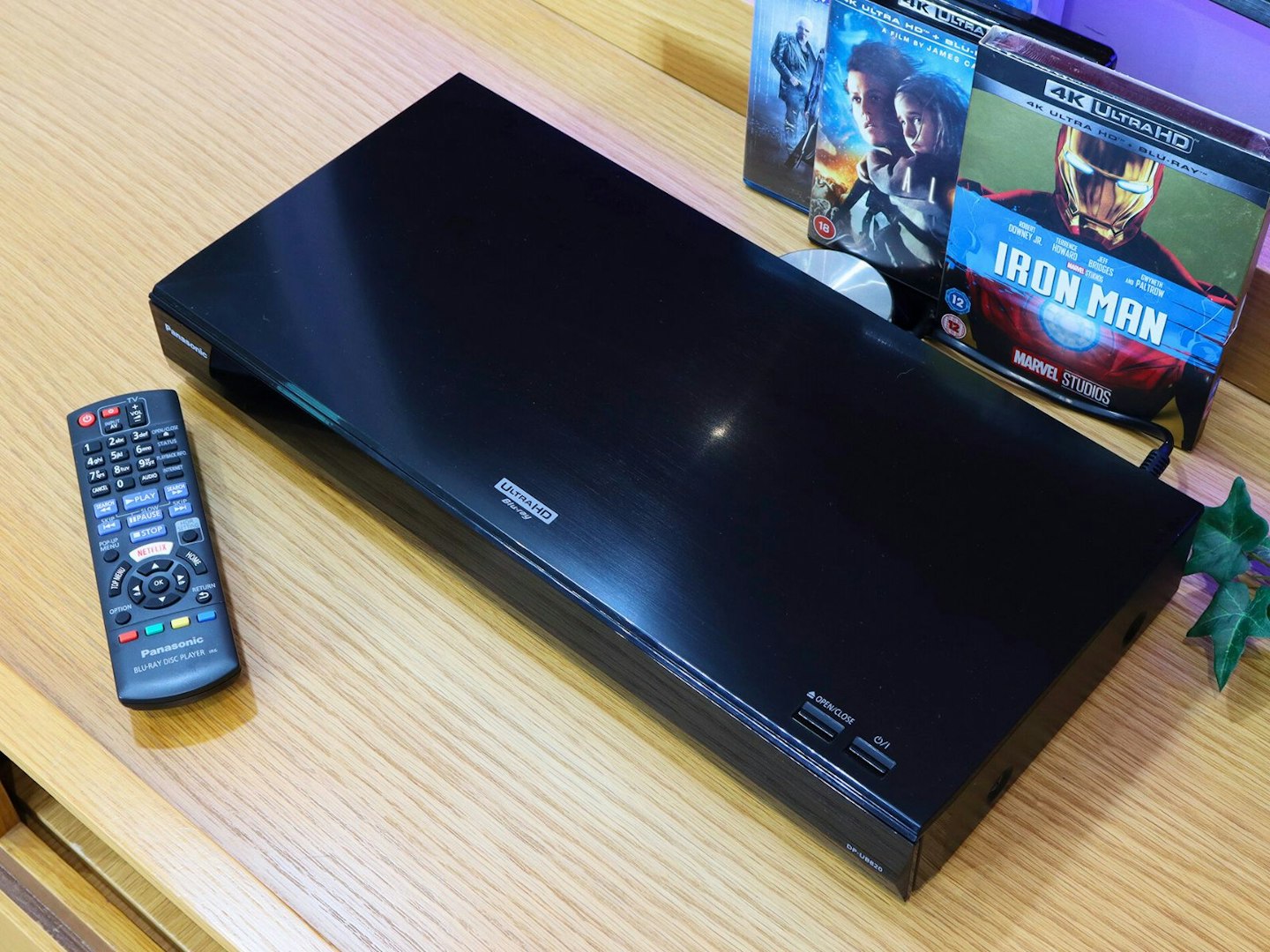
©Chris Duffill / Empire
We quite like the whole ‘nothing to see here’ aesthetic – it’s very much a player that’s designed to slot into your AV unit or under your TV and just do its job. It’s refreshing to see something so capable and solidly built without shouting about it in the form of oversized logos or clutter.
Connections And Set Up
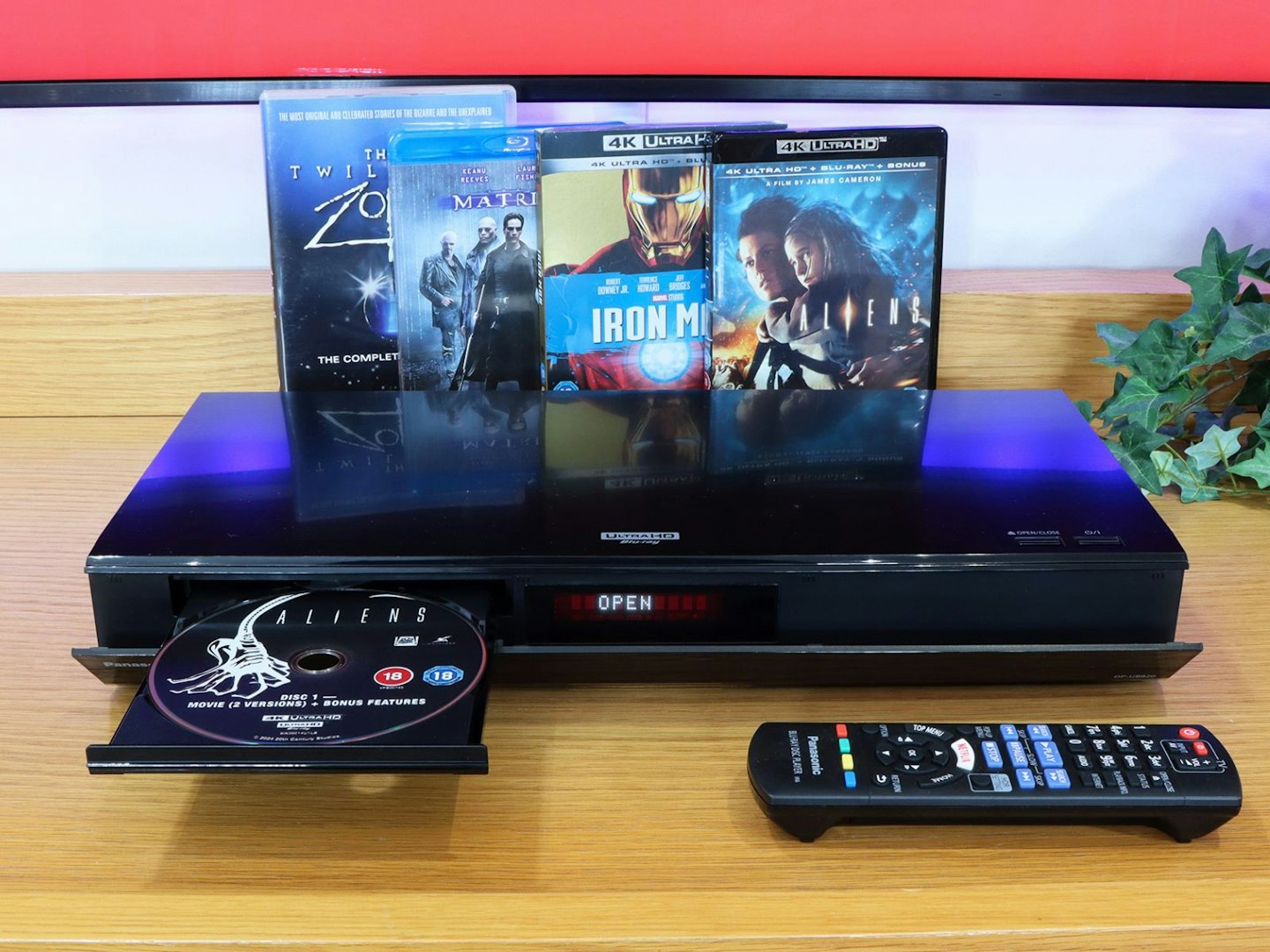
©Chris Duffill / Empire
The player has a wide range of outputs for sound, but its main audio-visual connection is HDMI. We’re happy to see that there are two HDMI outputs: one for connection to a TV and a second one for audio-only. We simply used one HDMI (audio and video) cable to connect it to our soundbar, which in turn passes the player’s video signal through to the TV via its ARC-enabled HDMI port. Connecting things this way meant fewer untidy cable runs between the TV and each device. Thankfully, this is Wi-Fi enabled too, so getting this onto our network for updates, streaming and more was a breeze.
Rear panel: Inputs And Outputs

The inclusion of a set of 7.1 analogue outputs are a welcome addition to the Panasonic DP-UB820EB Blu-ray Player. ©Chris Duffill / Empire
Other than HDMI connectivity, the rear panel also has a second USB 3 port for hooking up external storage drives for photo and video file playback. Elsewhere there’s an ethernet port for those who like to use their network the wired way, and a Digital Optical output. The latter will please music lovers looking to take advantage of the player’s Digital To Analogue converter for CDs and so on. However, unlike more expensive models, there’s no digital coaxial output for connecting to amplifiers. There’s no SD card slot either, so you’ll need a USB-based SD card reader for viewing your home videos.
One final surprise on this busy back panel is the inclusion of eight phono outputs for connecting this to a 7.1 surround AV receiver. Yes it’s analogue, but 7.1 audio is far from outmoded and will be welcomed by anyone hanging on to older home cinema kit.
Design And Build: Less Is More?
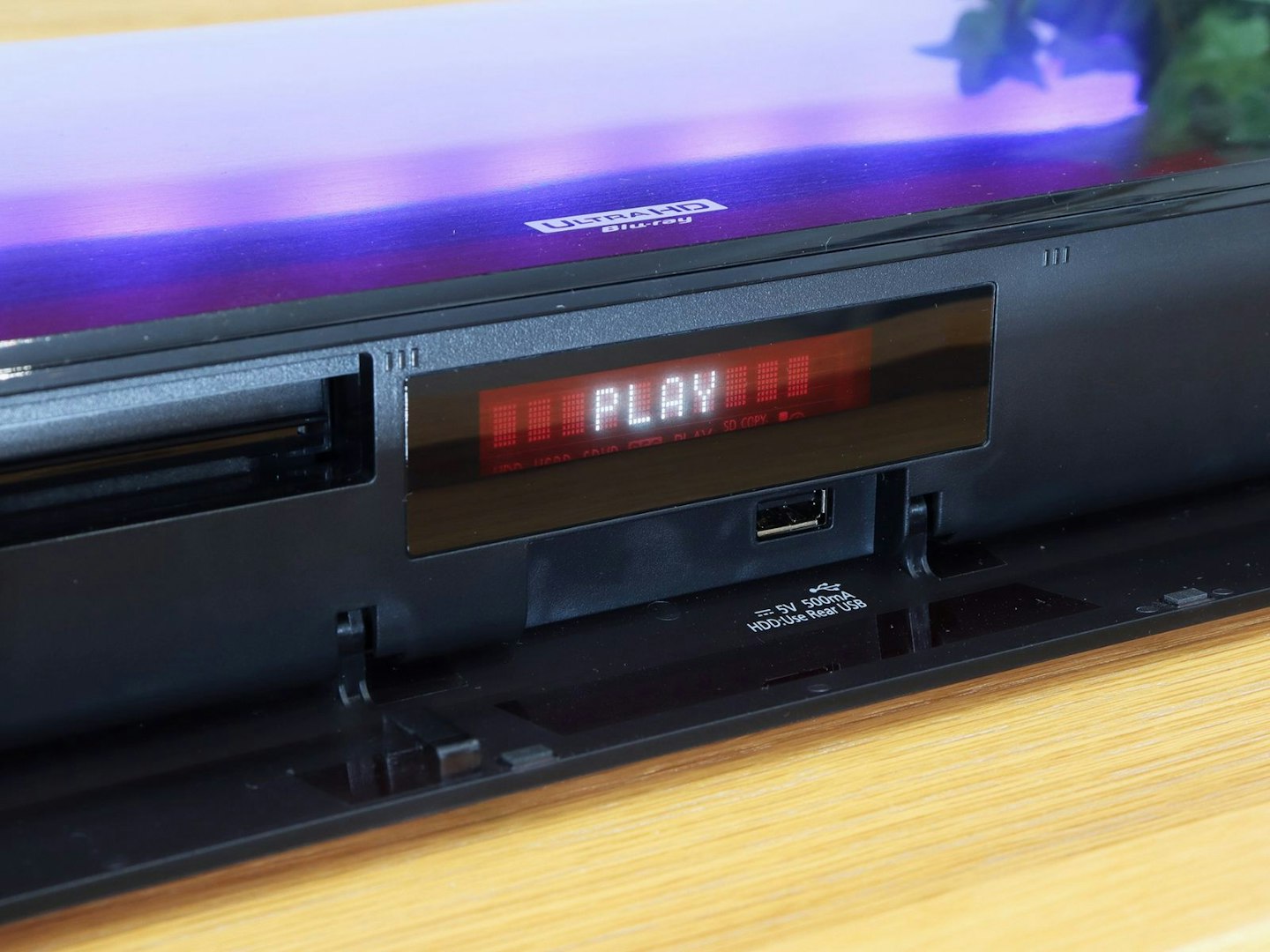
The entire front flap of the Panasonic DP-UB820EB only hides the disc tray, display and a USB port. ©Chris Duffill / Empire
Despite being quite light for its size, it’s very sturdy. That lightweight feel is a common feature of modern devices with ever-smaller internals – they could probably be half the size, but they’re designed to have a larger presence on the shelf.
Turning back to the design, there’s little to look at without opening that front flap. It comes across as something of a hangover from older units that had a lot more to hide. As it is, the whole of the front flap is basically there to conceal the disc slot, the small LCD display, a handy USB port, and not much else.
Remotely Familiar
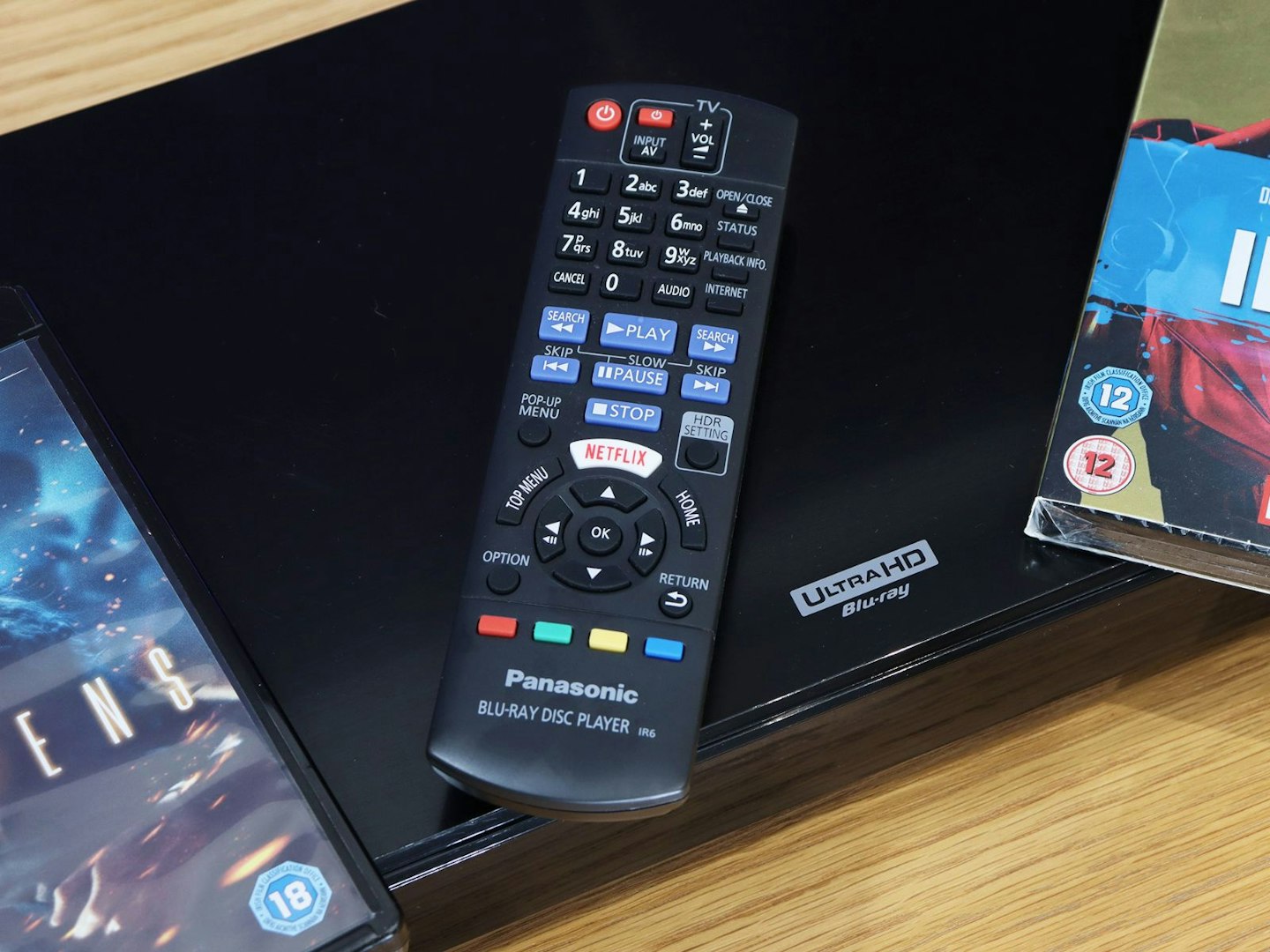
©Chris Duffill / Empire
Having owned a lot of Panasonic kit, the DP-UB820EB remote is very familiar. Our only real criticism is that there’s an over-abundance of buttons – not a major downside, but it would have been nice to have a backlight to assist when watching movies in a darkened room. That said, it does sit very nicely in the hand and all of the main playback controls are large and easy to find. During our testing we liked the dedicated HDR Settings button – a welcome alternative to getting lost in sub-menus to change the player’s HDR mode for the best picture.
Settings And Menus
There’s something a little dated about Panasonic’s homepage menu design compared to modern TVs and streaming devices, but that’s much less of an issue here with so few viewing options to choose from. Disc playback aside, you’re looking at using a handful of apps or accessing content on external drives. And we’re happy about that – it keeps the primary function of this Blu-ray player front-and-centre.
Other Menus are much the same story in terms of design, but are still highly usable and easy to read. The Operation and Setup menus are clearly organised, with playback settings and other Dolby Vision, picture and sound adjustments, networking and more.
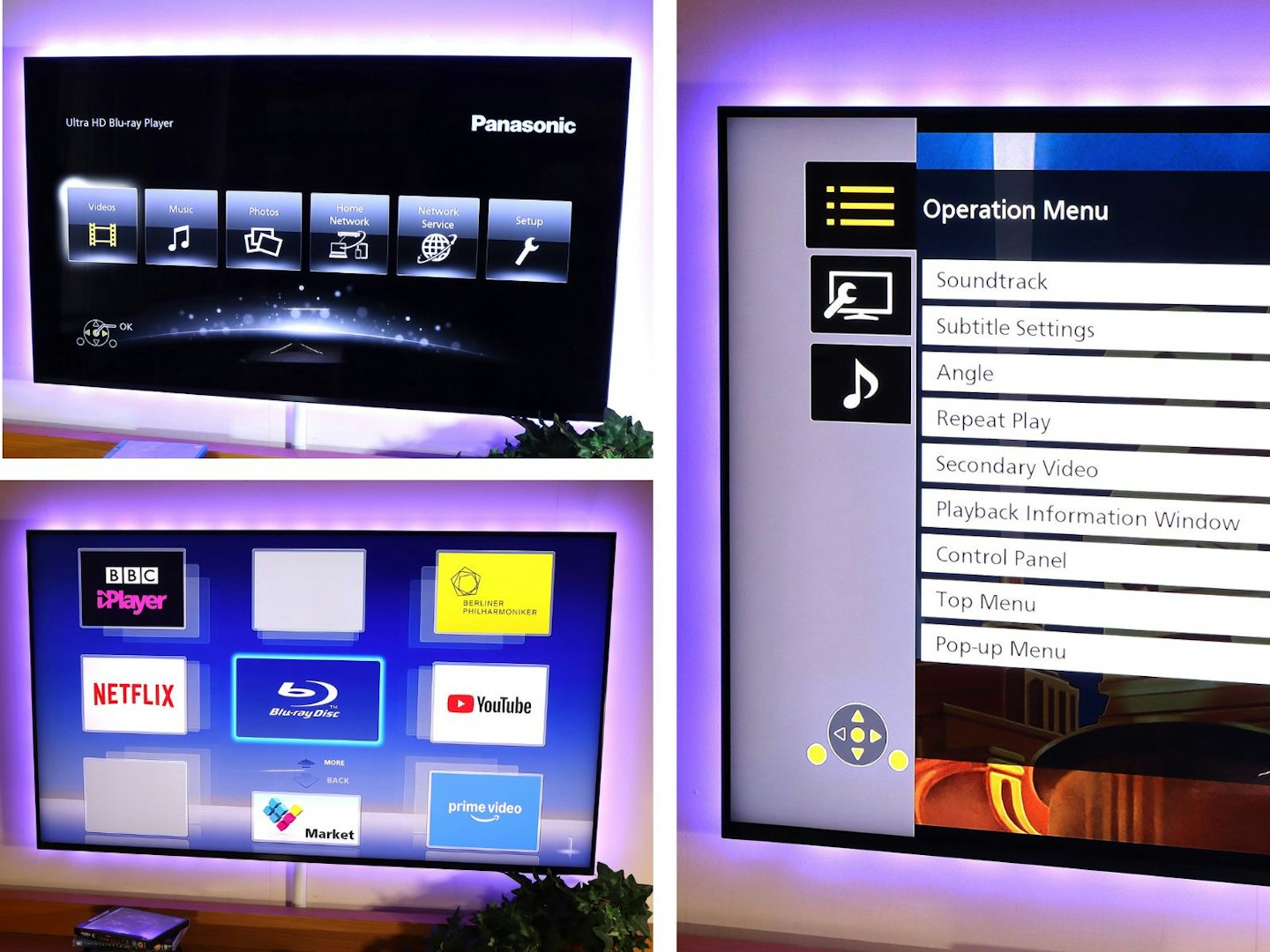
The menu design on the Panasonic DP-UB820EB Blu-ray Player is a little dated, but clear and efficient. ©Chris Duffill / Empire
Streaming Apps
While most smart TVs have more apps than you can shake a remote control at, Panasonic’s choice to include streaming apps here could be seen as a little redundant. However, for anyone who watches more disc-based content than streaming, the limited app inclusion is still a welcome and potentially practical option. If you’re often frustrated with switching your TV input between Blu-ray player and TV smart apps, this Panasonic could be a one-stop-shop for your evening’s entertainment.
Picture Processing On The Panasonic DP-UB820EB
Perhaps the most important component of this player is the Hollywood Cinema Experience (HCX) picture processor. It’s the same chip as the one in the company’s flagship player, the Panasonic DP-UB9000EB1, that costs an eye-watering £1000. This tech comes from the Panasonic Hollywood Laboratory, working in tandem with movie studios, to perfect the colour and output of your movies and shows. That also includes superior HDR Tone Mapping which dynamically alters the brightness to reveal subtle variations in tone and colour, as well as more nuanced shadow detail. Many TVs have this technology, but given Panasonic’s close ties with Hollywood, we’re excited to see how the DP-UB820EB competes.
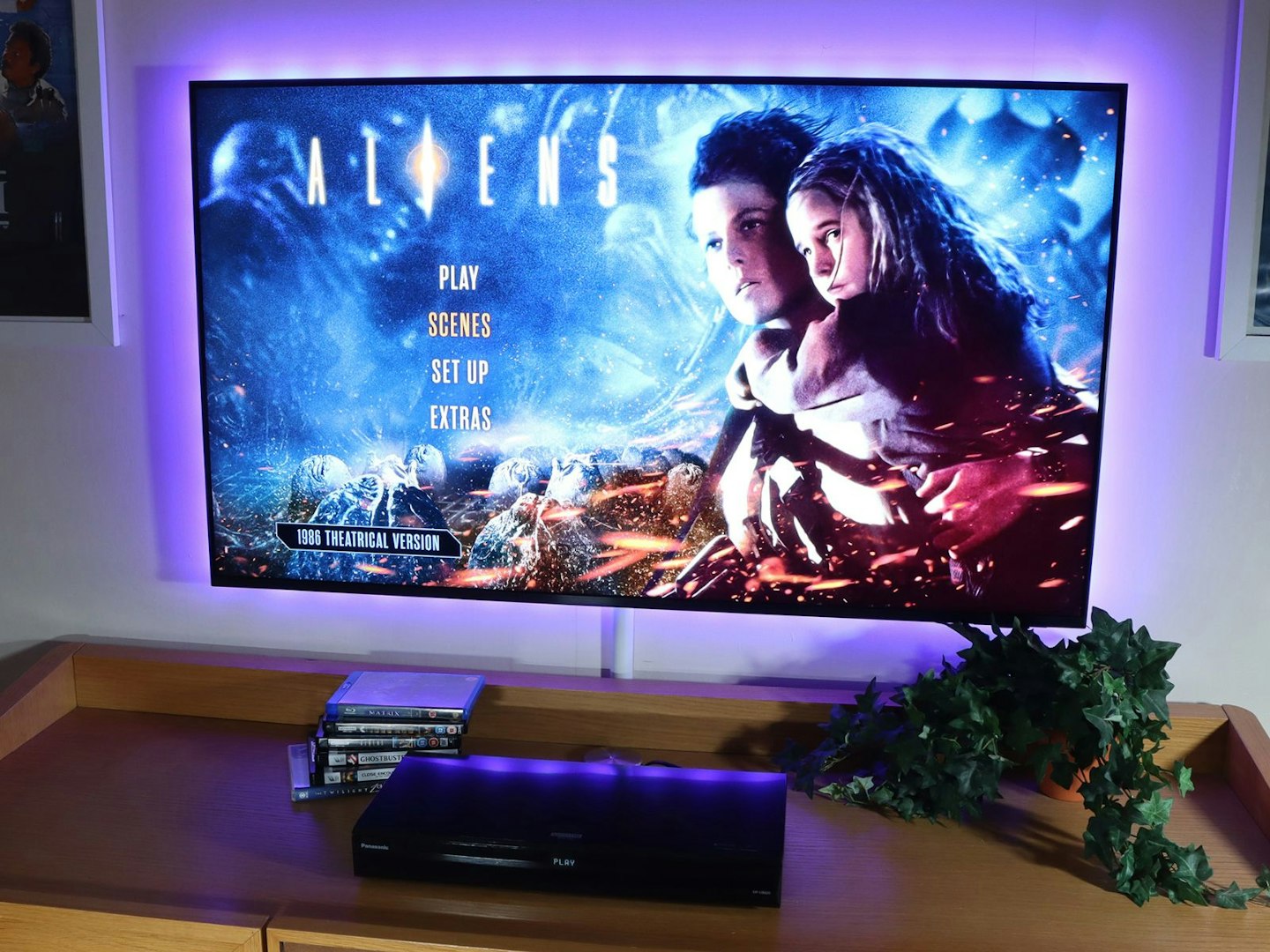
The main menu of Aliens in 4K offered a early glimpse of the extra colour range supported by the Panasonic DP-UB820EB ©Chris Duffill / Empire
Upscaling
There’s nothing for us to do here, as the player automatically detects the resolution of the content you’re watching and applies 4K upscaling on the fly. We’ll be putting this to the test below, but Panasonic do indeed go so far as to claim this works with our old friend the PAL resolution DVD. That means taking a 720 x 576 resolution image, reducing a considerable amount of noise and artefacts, and using some clever processing to scale it all up to 4K in a sharper, contrast and colour-boosted form.
Dolby Vision and HDR
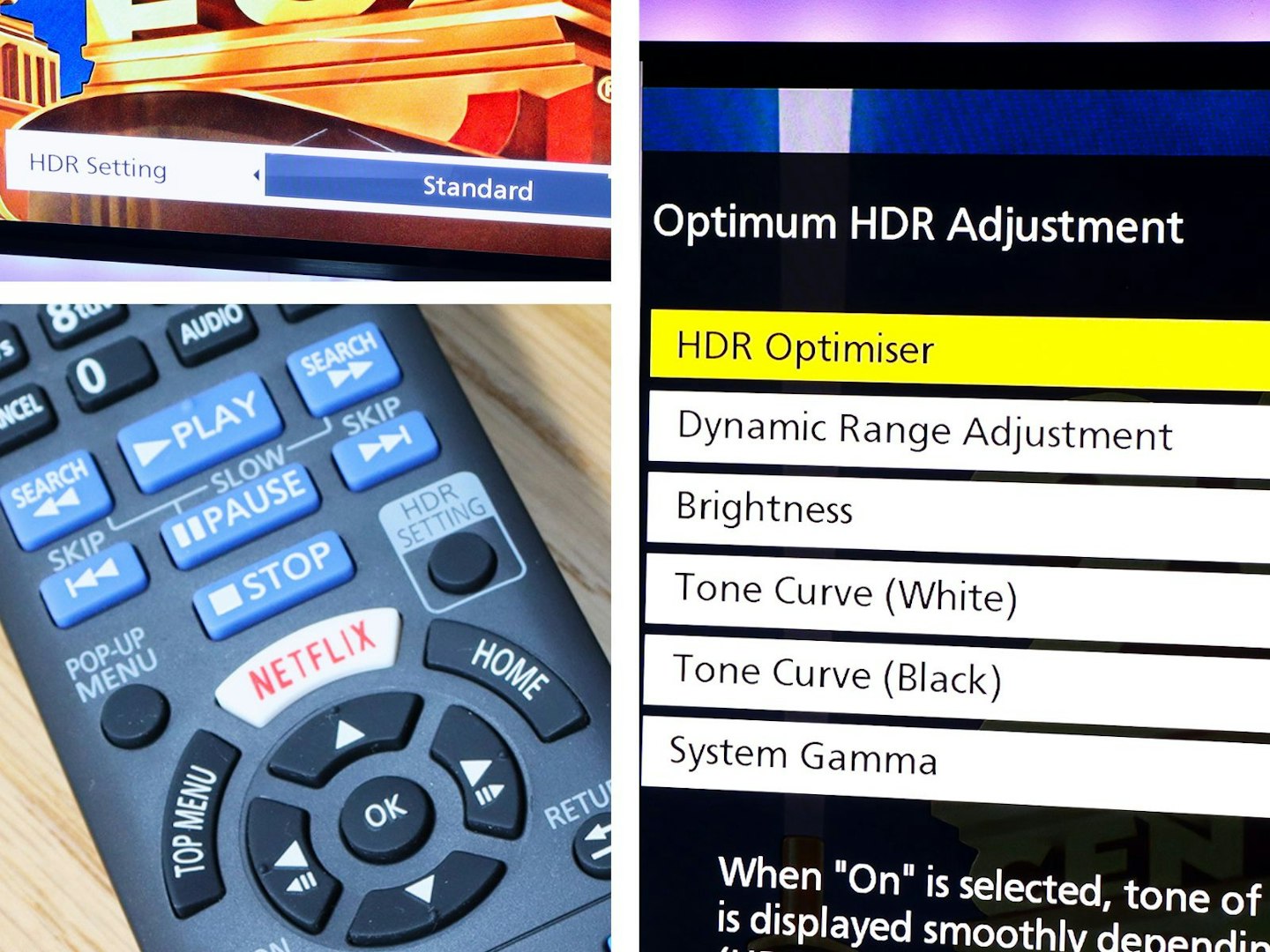
The dedicated HDR Setting button can be short-pressed for quick changes, or long-pressed for more in-depth options. ©Chris Duffill / Empire
It’s worth mentioning that this player’s tone mapping (seen in the menu as ‘HDR Optimiser’) only works on content that uses HDR10, so you won’t see any improvements here with other HDR versions. Thankfully, Dolby Vision incorporates it’s own tone mapping at the source. That said, if your TV has it’s own HDR tone mapping function you still might want to compare it with the Panasonic and choose the one you like best. The 55-inch QLED TV we used for testing doesn’t have it’s own tone mapping feature, so we could really judge the results of Panasonic’s version as we tested.
Using that dedicated button on the remote we mentioned earlier, you can toggle between four HDR settings that essentially leverage the extra effect that HDR processing can have on overall picture brightness to make things easier to see. There’s Standard, Natural, Light or Bright environmental presets to choose from. Standard was fine, and Natural did give a more naturalistic tone, but other modes that try to compensate for viewing in bright rooms were too harsh for us as we like visuals that stay as true to the director’s intentions as possible – but it will definitely come in handy for those who have their TV in a room that suffers from excessive sunlight. Thankfully, holding down that HDR button takes you to a larger menu where you can tweak the individual settings to alter the HDR optimisation to suit.
Performance Tests: Panasonic DP-UB820EB Blu-ray Player
The Matrix (1999) Blu-Ray, 1080p, Dolby TrueHD
A staple of many sci-fi fans’ collections, this first film in the original Matrix trilogy is the standard full-HD Blu-ray version – a format that doesn’t support HDR. So, we really wanted to see how the Panasonic would upscale this to 4K, but also how the picture processing would handle the superlative colour grading that tells us so much about the storyworld.

©Chris Duffill / Empire
The results were excellent. The 1080p upscaling absolutely delivered an uptick in detail and sharpness. Even better, the film grain was retained – which means that this player is sophisticated enough to avoid ironing out those finer details. Lastly, the greenish tint to sequences set inside the Matrix was just right – not overcooked but still registering, with contrasting scenes set in the world of The Machines having a cooler palette with harsher contrast.
The New Twilight Zone (1985) DVD, PAL, Dolby Digital 2.0
Perhaps the acid test for any smart TV or Blu-ray player is upscaling PAL format DVDs. With a resolution of 720×576 pixels, the Panasonic would have much more work to do than it did with The Matrix‘s 1080p. Our choice here is the 1985 reboot of Rod Serling’s classic The Twilight Zone.
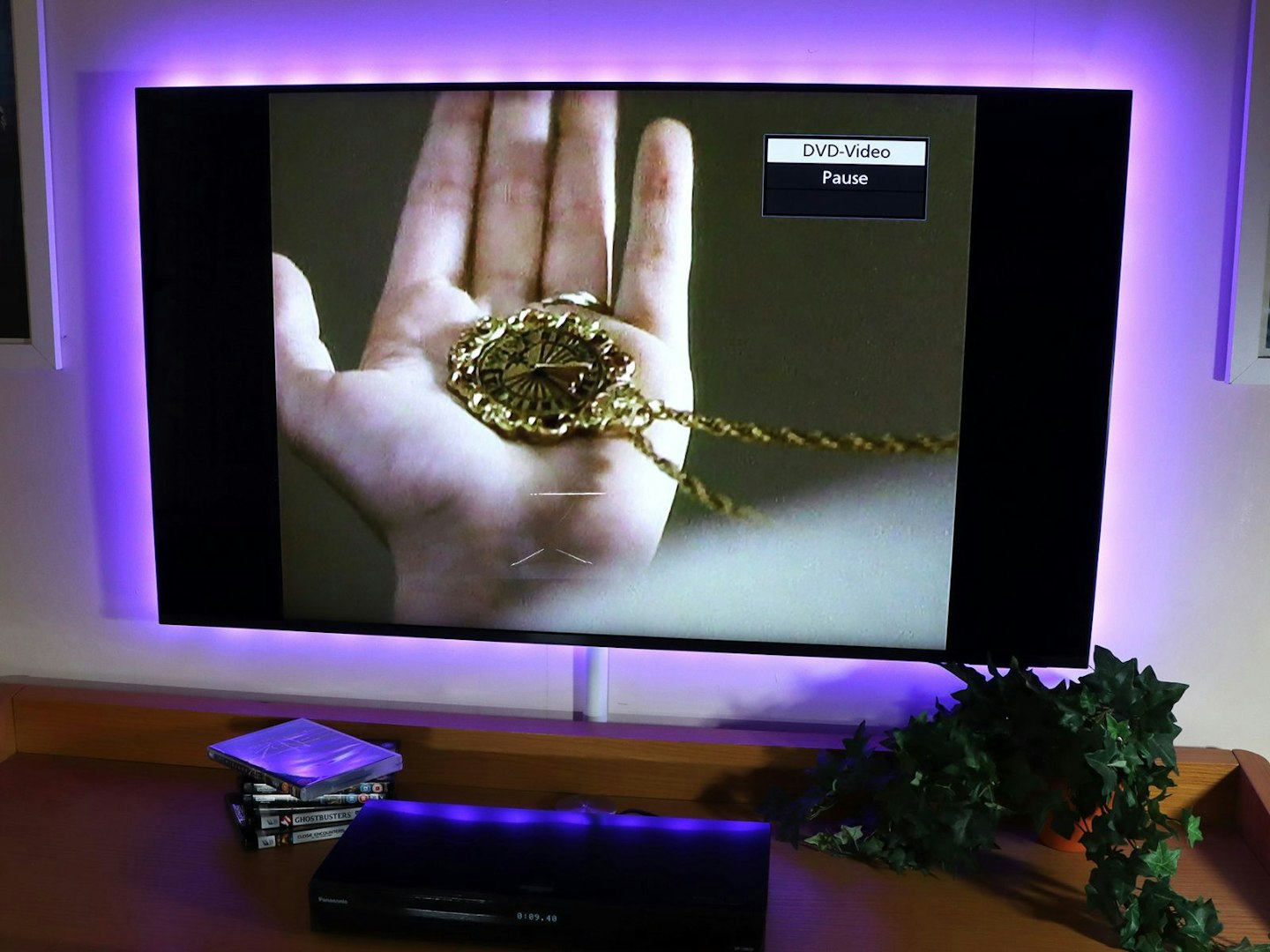
This pendant can stop time in this episode of The New Twilight Zone – thankfully we can also do that with the players Pause button. ©Chris Duffill / Empire
Bearing in mind that this show has been converted to PAL from a lower resolution North American source, we were quite impressed with the results. The second story of season one’s opener, A Little Peace And Quiet, was noticeably sharper than normal – despite the rest of the upscaling only enlarging indistinct areas of the original. That said, the Panasonic (like any upscaler) can only do so much with low-res source material. Outside of time-consuming projects that aim to upscale video using AI, this is as good as it gets.
Iron Man (2008) Blu-Ray, 4K UHD, HDR10, Dolby Atmos
Our first toe in the water with 4K Blu-ray is also a first in its own right: 2008’s Iron Man. It’s the movie that kickstarted the Marvel Cinematic Universe. It’s also a great test for the Panasonic’s HDR10 performance and HDR Tone Mapping feature.
As a film that’s been mastered digitally, the colour and detail were spectacular (and even better when we turned on the HDR Optimiser). The tone mapping made a fairly noticeable difference to the contrast, introducing subtleties in colour, brightness and shadow detail. We’d say it’s on a par with the incredible tone mapping of the high-end Valerion VisionMaster Pro 2 projector we reviewed.
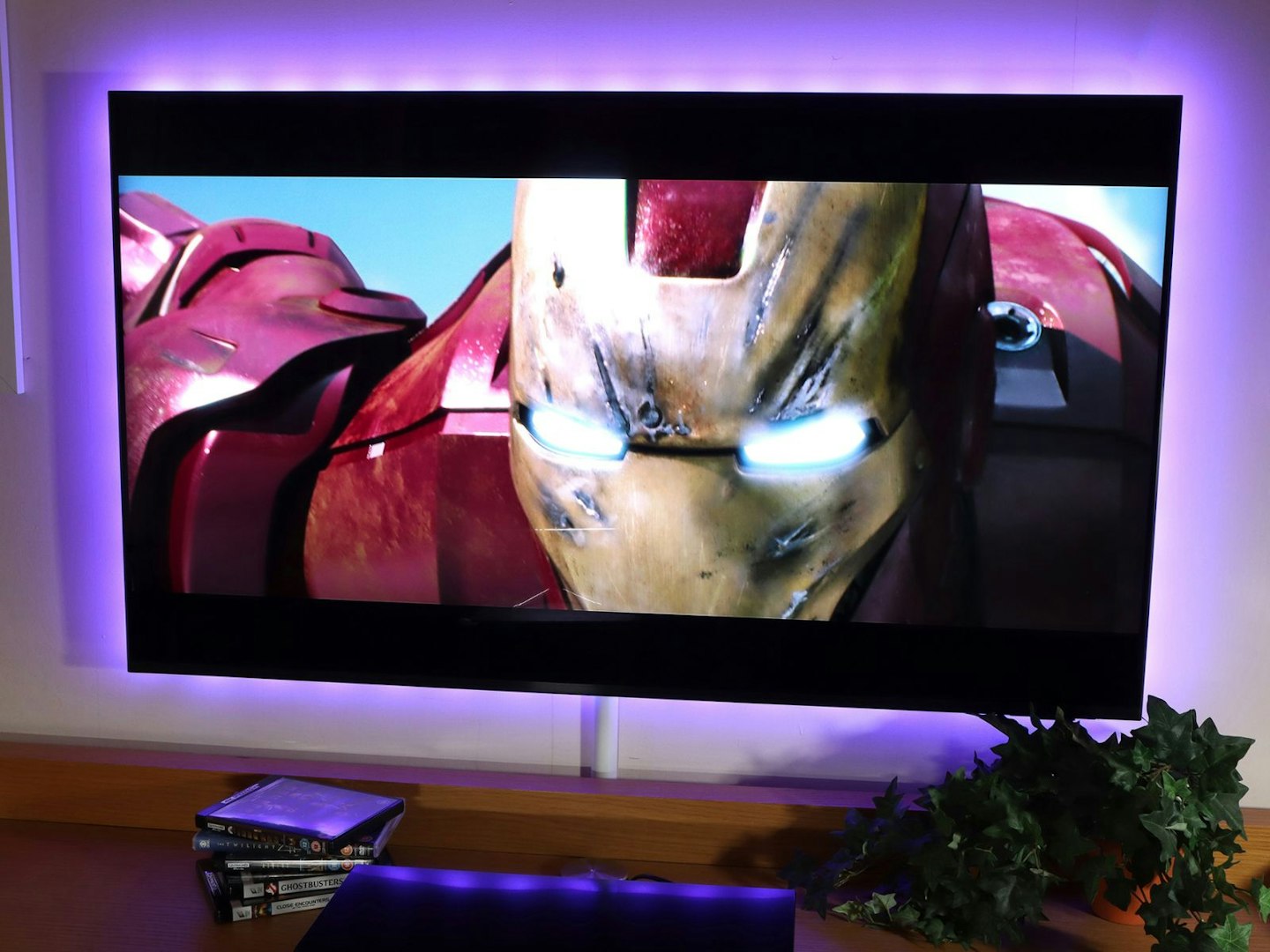
©Chris Duffill / Empire
Although Panasonic’s surround sound support is anything but an afterthought, it simply does its job. We were happy to hear that the player does indeed pipe Dolby Atmos out to our soundbar, as it did for all of the other supported formats.
Aliens (1986) Blu-Ray, 4K UHD, Dolby Vision, Dolby Atmos
Our final test was another 4K Blu-ray – this time with Dolby Vision. However, we also chose this Aliens disc for its variety of extras as an excuse to test the player’s speed and responsiveness. Navigating menus and launching features was expectedly snappy, with good disc access times. But, back to the movie itself.
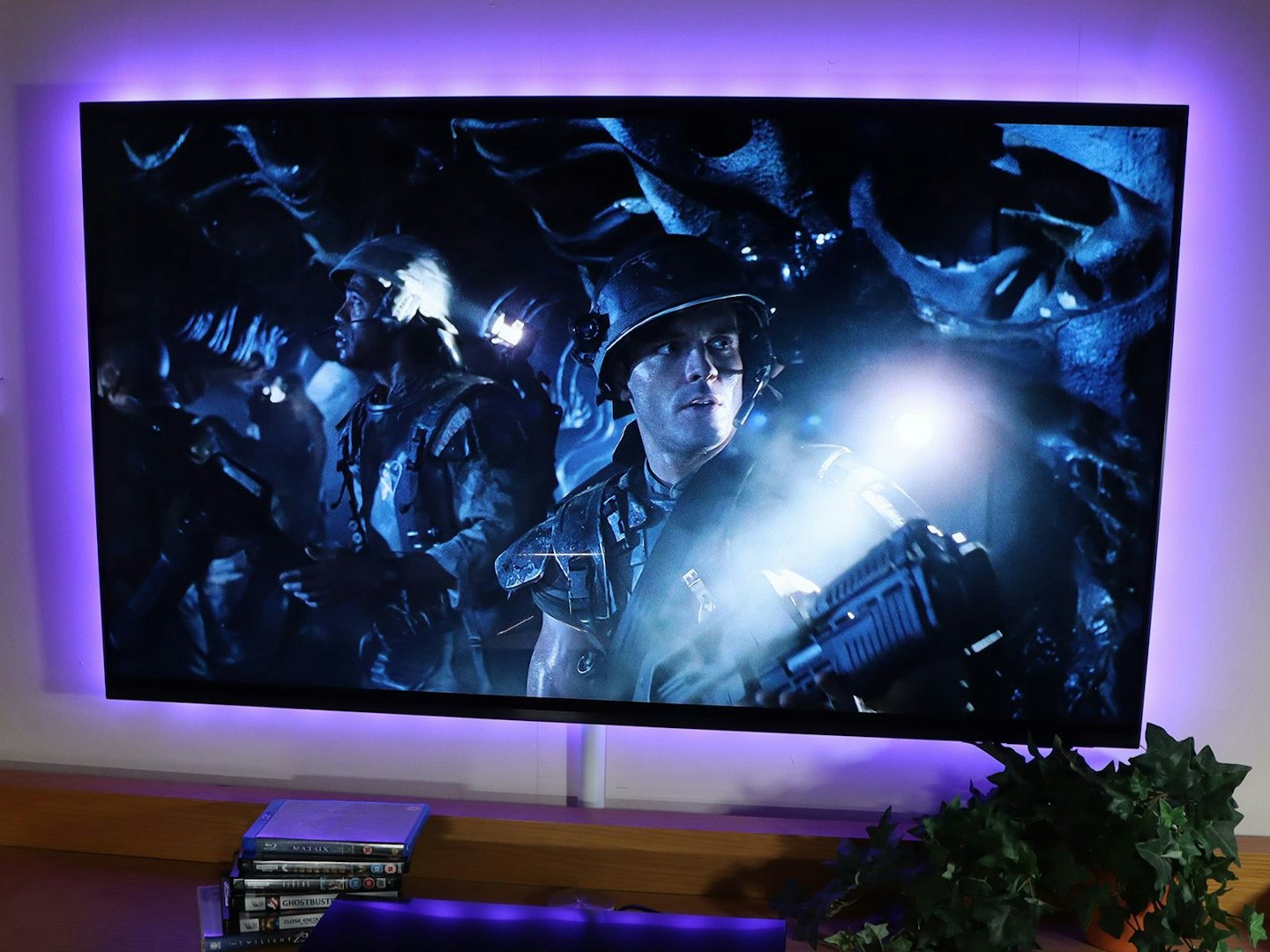
©Chris Duffill / Empire
Given that this film is notorious for dark scenes (and that Dolby Vision is already tone-mapped) we were hoping for a combination of well-gradated colour and unparalleled shadow detail. We weren’t disappointed. Those Xenomorphs stayed hidden from view when the scene demanded it, but were revealed in the walls of the atmosphere processing station on LV-426. Lesser versions we’ve seen on inferior players would simply plunge them into a void of overcooked black levels.
Streaming Content
While we found streaming quality to be nice and stable, the fact that this player only comes with YouTube, Amazon Prime, Netflix and a very small handful of others is a real limitation. Yes, there’s an app store of sorts, but you won’t find current (‘plus’-obsessed) must-haves like Paramount+, Disney+ or Apple TV+. It’s also noticeably sluggish compared to the average smart TV.
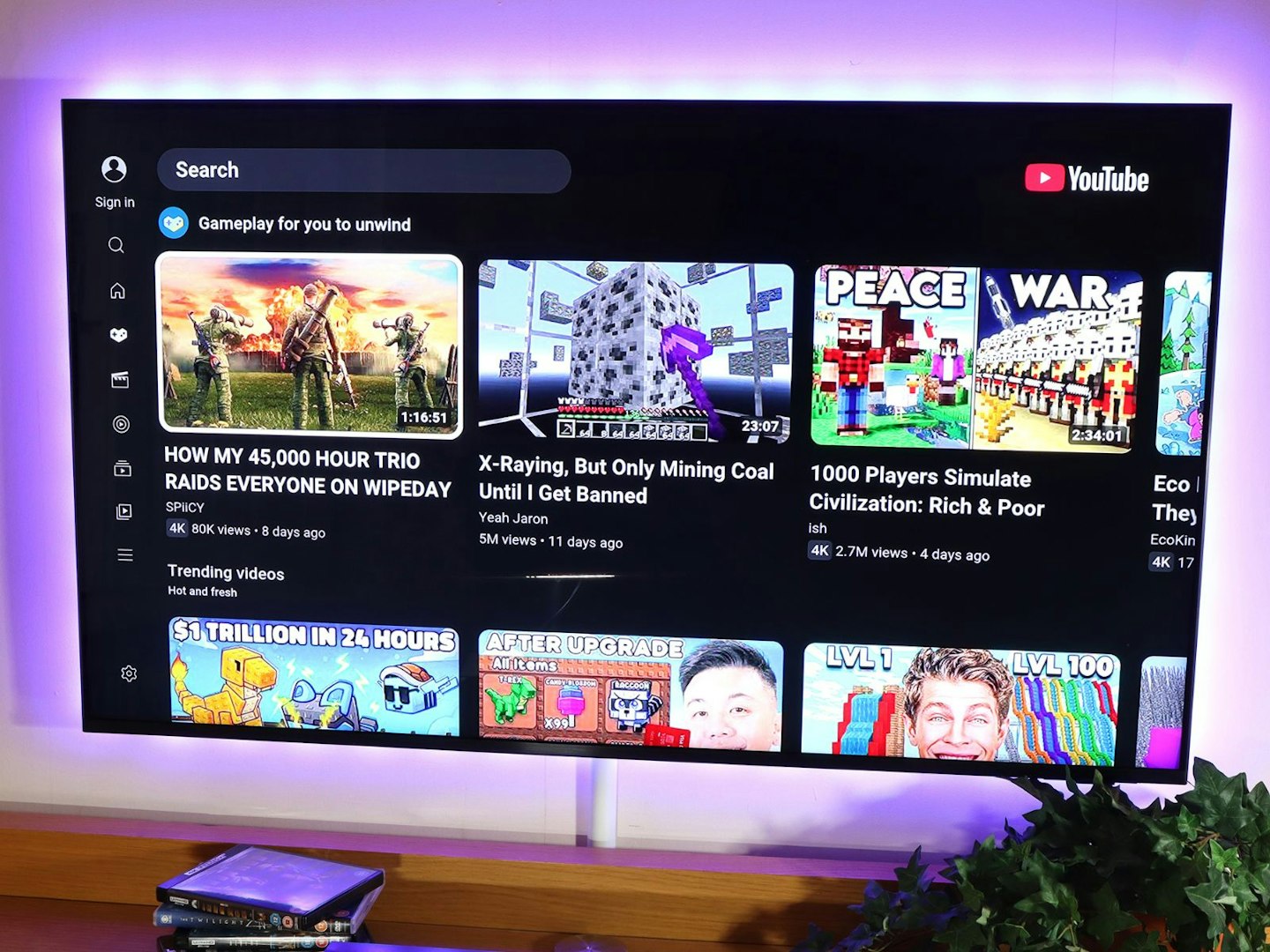
©Chris Duffill / Empire
So, aside from streaming content from your own local servers, the player’s Wi-Fi connection is a little limited in use. Fine for the odd spot of YouTube after you’ve finished spinning a 4K disc, or movies on Prime or Netflix, but this player is understandably much more serious about discs than it is about streaming.
Music Output
If your music setup is lacking its own CD player, the Panasonic’s built-in DAC (Digital to Analogue Converter) has a respectable 192-kHz/32-bit spec, so you absolutely can use this for your listening. But it’s not all about CDs, as the DP-UB820EB can handle Hi-Res music formats such as DSD, ALAC, FLAC, and more – so if you’re going to stream music with it instead, it’s a very capable unit.
We paired the Panasonic DP-UB820EB with a Marantz PM6007 amplifier and KEF Q350 speakers via an optical cable. Listening to Sign of the Gypsy Queen by April Wine was indeed a more organic listen than usual, but the amp itself also has a DAC that can’t be defeated, so its fair to say that the Panasonic player’s DAC may also be rendered invisible for those with more capable amplifiers.
Who should buy the Panasonic DP-UB820EB Blu-ray Player?
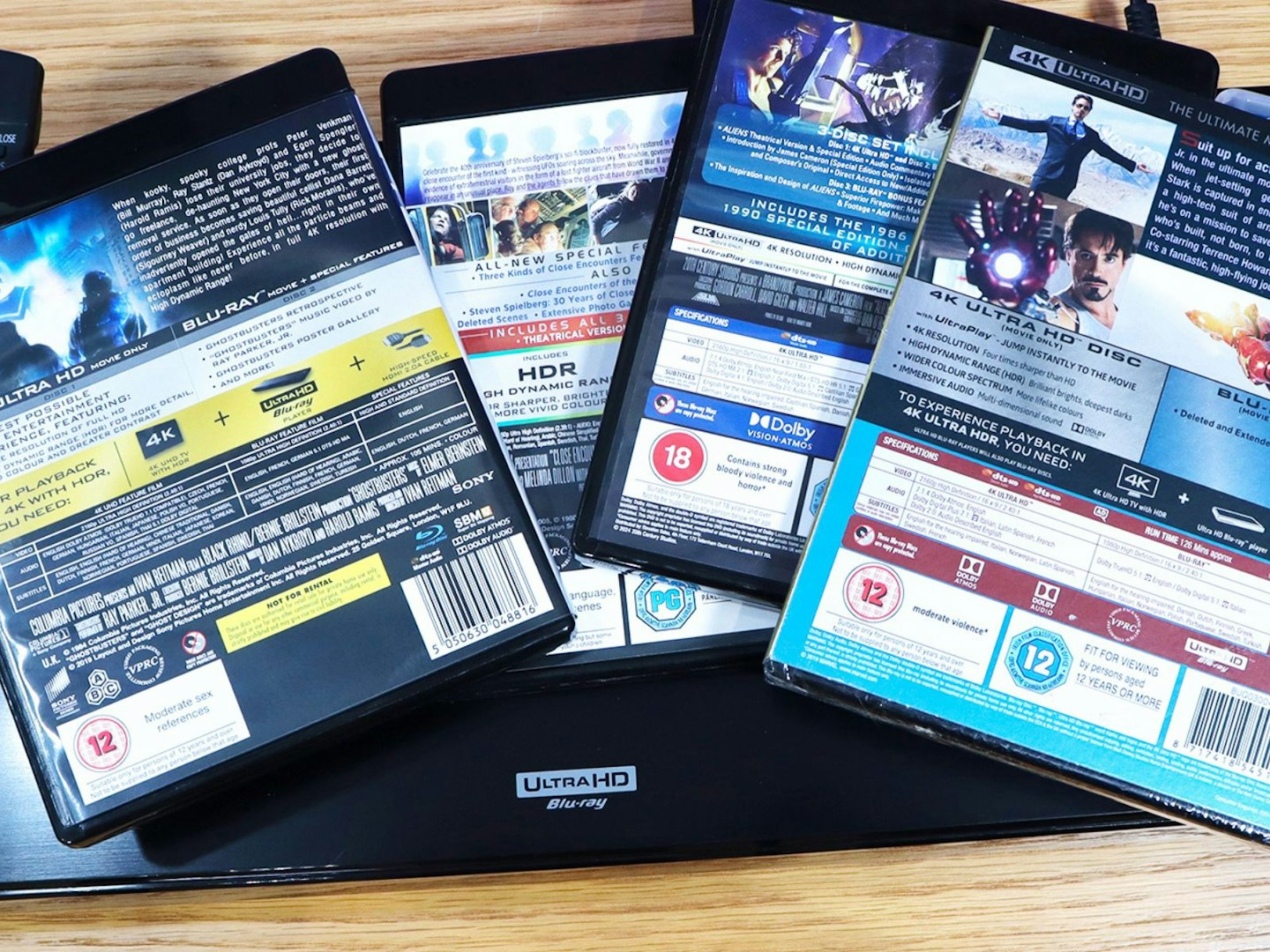
©Chris Duffill / Empire
We think that any serious movie or TV fan who wants to get the most out of their burgeoning collection of discs should put the Panasonic DP-UB820EB Blu-ray player right at the top of their wish list. It’s for anyone who’s ever stared at the logos on the back cover of a Blu-ray case and let out an involuntary sigh at all of those unsupported formats like DTS
Final Verdict
Based only on its no-frills looks, you’d be forgiven for thinking this was a much less capable Blu-ray player. As it happens, we were suitably impressed with its performance – from DVDs to standard Blu-rays and the 4K variety. The Panasonic Hollywood Lab credentials are its core strength. That HCX processor really does flex a lot of picture processing muscle, not only in its impressive and naturalistic upscaling, but also with its whole approach to colour and, of course, the tone mapping function.
We do think that the main home screen and menu designs need an overhaul (not to mention a speedier app experience), but given that this player is really all about exceptional disc playback, we’re not overly bothered by this. As mid-budget 4K Blu-ray players go, the Panasonic DP-UB820EB borrows much from the brand’s flagship model that costs three times the price. Packed with comprehensive format support and high-end tech, you won’t find better at this price point.
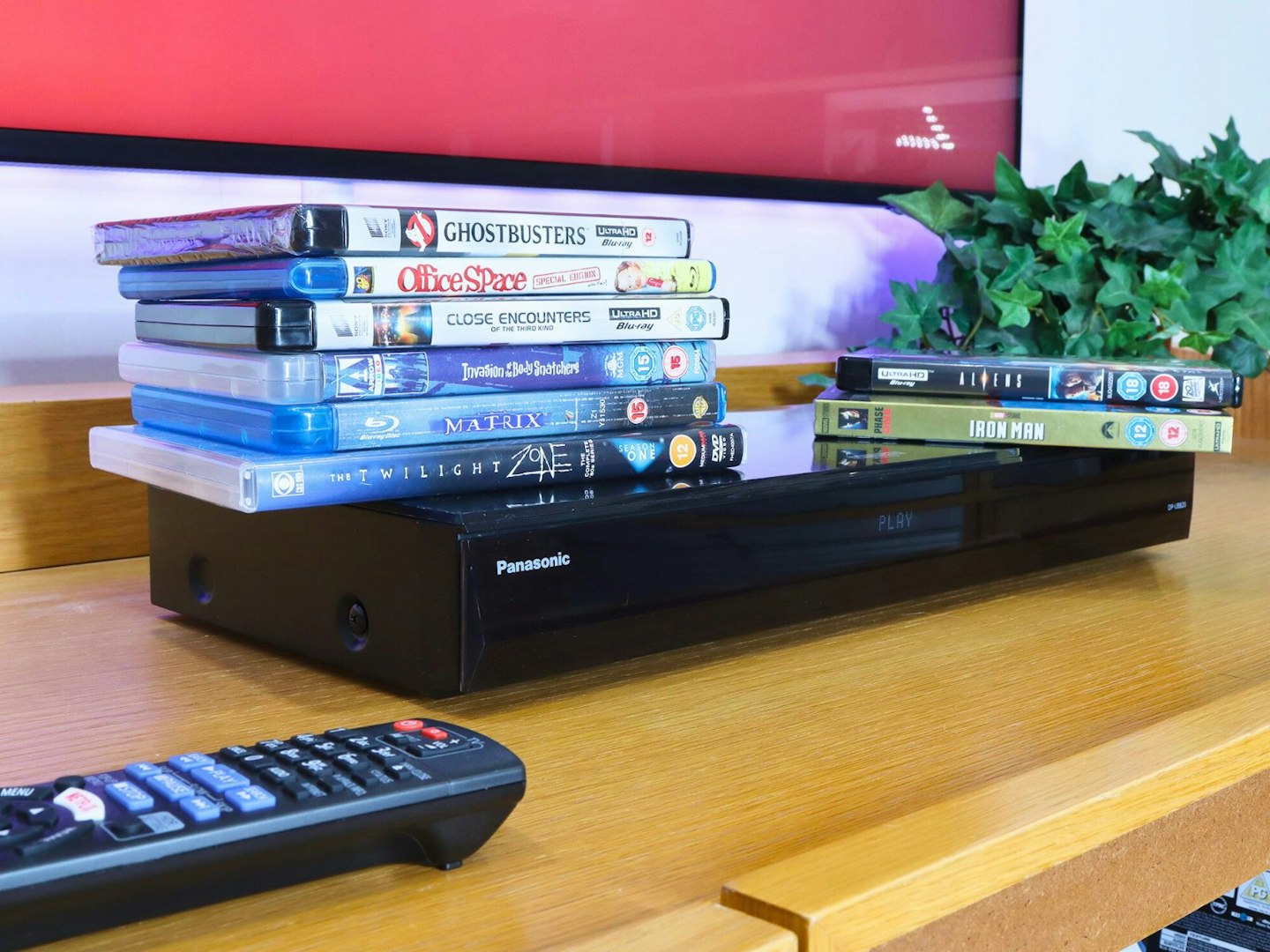
©Chris Duffill / Empire
Other 4K Blu-Ray Players To Consider
When it comes to 4K Blu-ray players with solid format support you’re really limited on choice. Our go-to brands here are Panasonic and Sony. Pound for pound, we like the Sony UBP-X700. It shares most of the features of the DP-UB820EB, including HDR10 – but it doesn’t support HDR10+, which is a bit of a shortcoming given the superior 10+ version is a feature of plenty of 4K discs.
Our second option as a more cost-effective alternative to the DP-UB820EB is the Panasonic DP-UB450EB-K. It’s almost two-thirds the price of the model we reviewed and includes Dolby Vision and Atmos , but you won’t find the HDR Optimiser. 7.1 audio out, or the superior upscaling and picture processing of the DP-UB820EB.
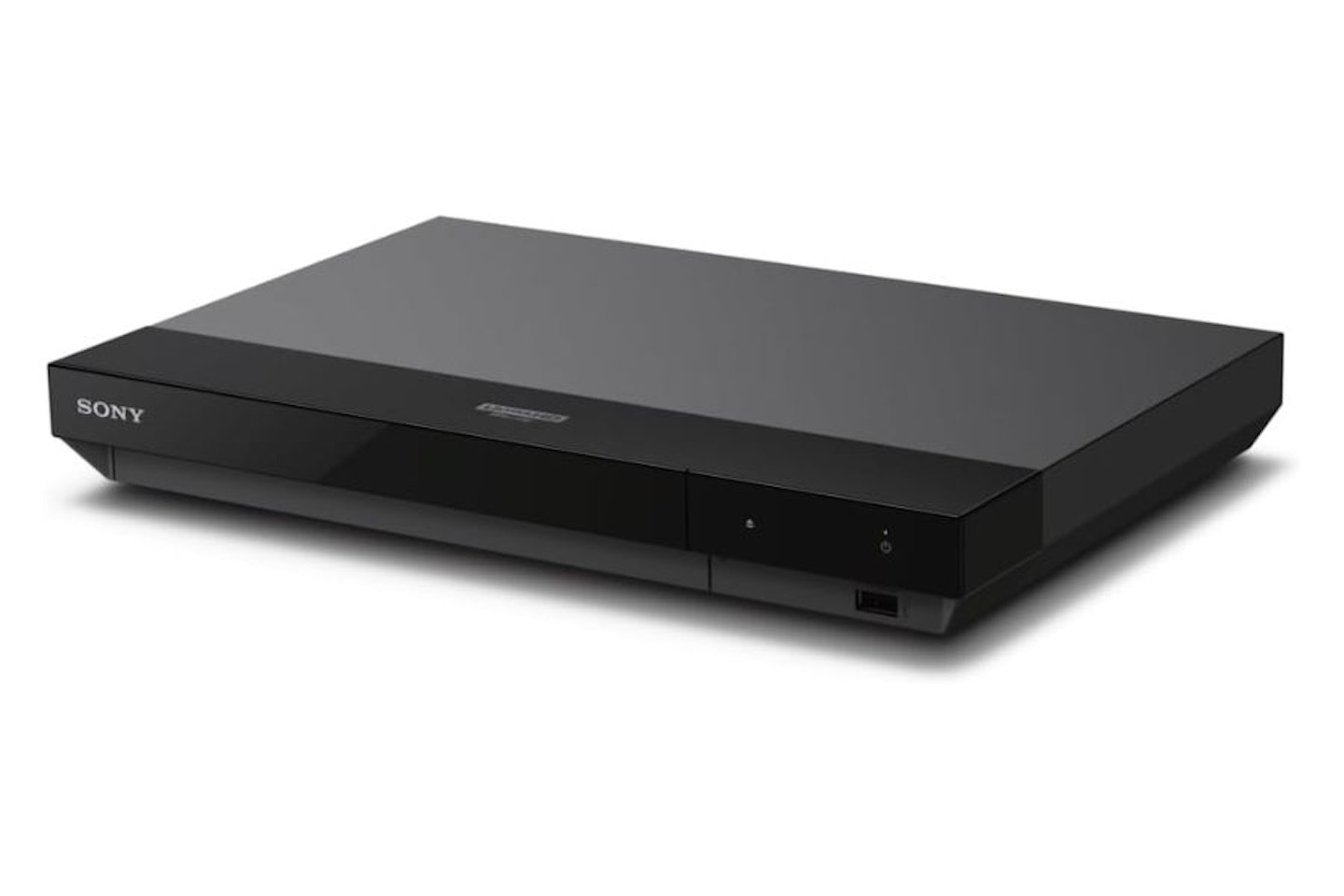 Sony
SonyWith great support for Dolby Atmos, Dolby Vision and HDR10, the Sony UBP-X700 is a smart-looking Panasonic alternative with excellent upscaling and picture processing features. Although, unlike the DP-UB820EB, it doesn’t support DTS
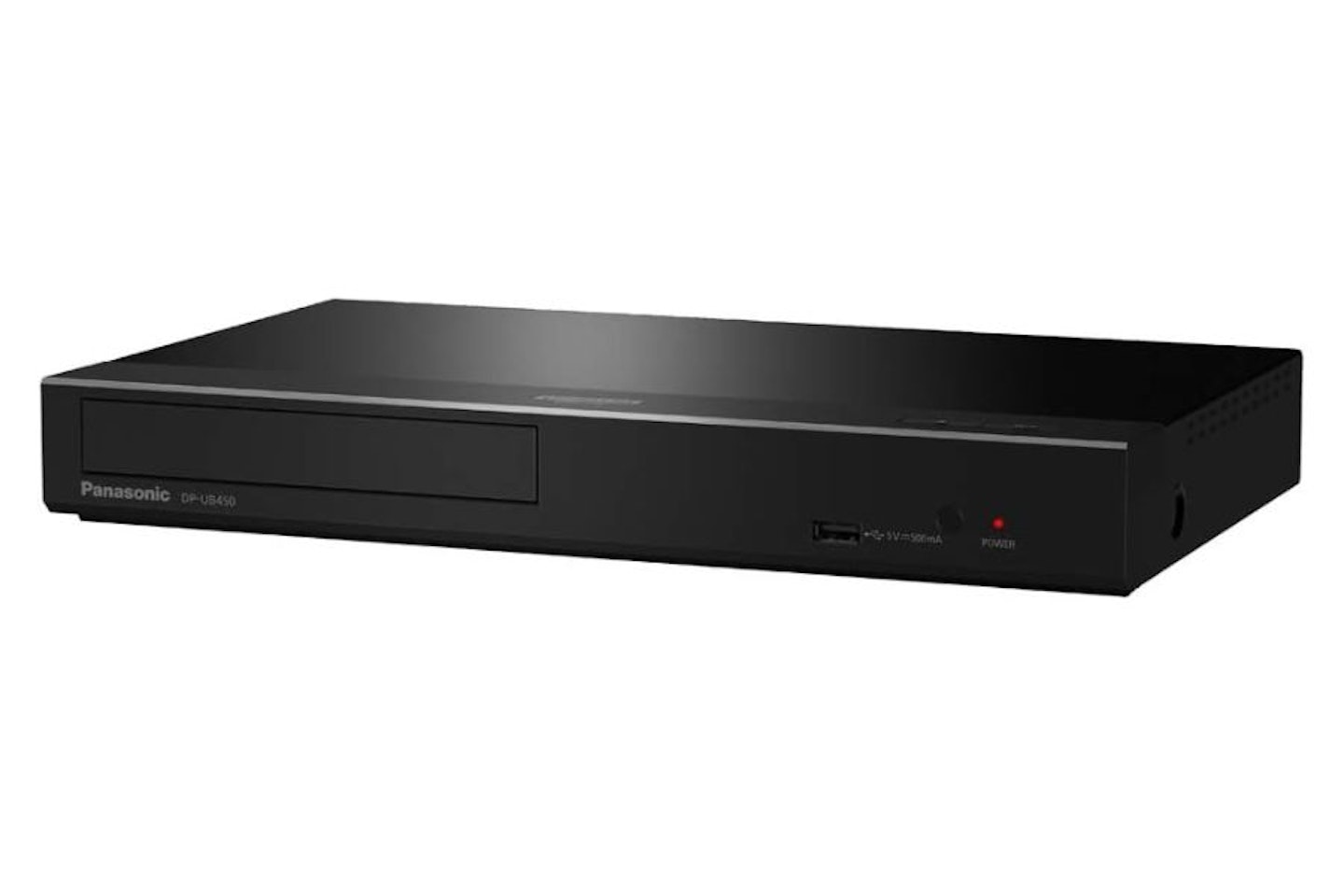 Panasonic
PanasonicA really cost-effective option for those who need 4K playback without the high-end features of the DP-UB820EB, the Panasonic DP-UB450EB-K retains enough to make it worthwhile, including Dolby Vision and Atmos support. It may not have the top-tier image processing of the model we reviewed, but it’s still going to do a stunning job for a player coming at less than £200.
How We Tested The Panasonic DP-UB820EB Blu-ray Player
The Panasonic DP-UB820EB Blu-ray Player was tested for around two weeks. It was hooked up to a Dolby Atmos soundbar via HDMI which then passed the video on to a Samsung 55-inch QLED TV over HDMI eARC. Discs tested for playback, menu responsiveness and extra features included The Matrix (1080p Blu-Ray), The New Twilight Zone (DVD), Iron Man (Blu-ray), and Aliens (4K Blu-ray) The player was connected to a home Wi-Fi 6 router and a variety of streaming content was viewed via Netflix and YouTube apps. The Panasonic DP-UB820EB was loaned to us by a PR agency for review purposes. Neither the agency nor Panasonic had any editorial input or oversight.
Who tested it?
Chris Duffill is a Senior Tech Writer and reviewer. Having worked in video production and graphic design, he has decades of professional experience with computers, laptops, cameras, and AV technologies. He’s previously owned and set up various home cinemas, using formats as ancient as VHS and as modern as Plex-based media servers. He’s a lifelong TV and movie fanatic with a Masters in Screenwriting from the UEA.
Latest Updates
This review was first published in July 2025. Any future updates and additions will be added here.
Chris Duffill writes for Empire, What’s The Best, Yours, Closer, Heat and other brands. He specialises in home entertainment and audiovisual tech, including TVs, projectors, speakers, amplifiers, turntables and more.



:max_bytes(150000):strip_icc()/F1-THE-MOVIE-061625-11-f296c37978b745f38243fce6e0904400.jpg?w=390&resize=390,220&ssl=1)
